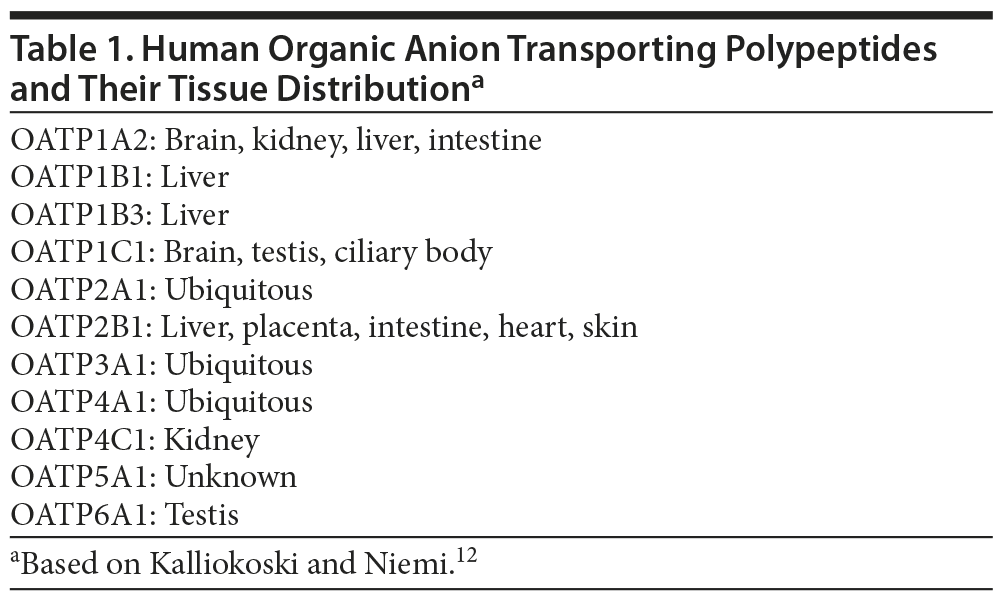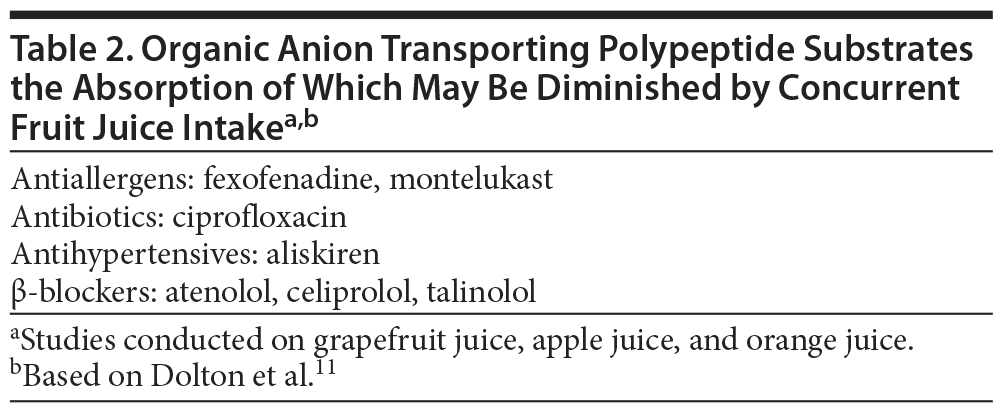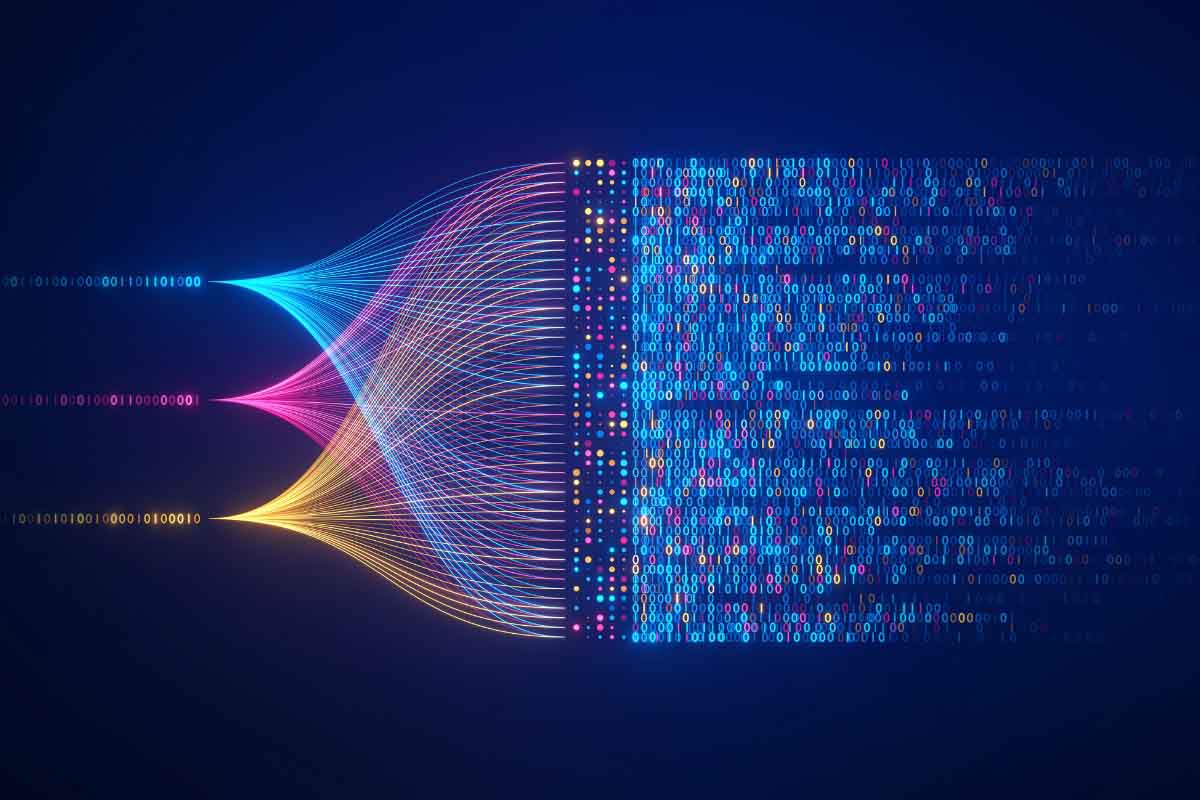Clinical Question
Apple juice and orange juice are popular beverages. Could drinking apple or orange juice regularly, or taking medications with these beverages instead of with water, result in clinically significant food-drug interactions in patients receiving psychotropic medications?
Fruit Juices: Benefits and Risks
Fruit juices contain vitamins, antioxidants, electrolytes, trace elements, and other nutrients that are associated with potential health benefits; for example, constituents with anti-inflammatory, antioxidant, antiobesity, antidiabetic, and antitumoral properties have been identified in pomegranate juice.1,2 This may explain why fruit juice intake is associated with clinically relevant gains in observational studies; for example, the regular intake of fruit and vegetable juice may delay the onset of Alzheimer’s disease.3
Apples are traditionally associated with large health benefits, as implied by the proverb “An apple a day keeps the doctor away.” In vitro, in vivo, and even clinical data on the antioxidant, antiproliferative, and cell signaling effects of apple juice suggest the possibility of benefits related to cognitive decline of normal aging, diabetes, weight management, bone health, pulmonary function, and gastrointestinal function.4 Orange juice is similarly associated with health benefits. For example, orange juice reduces low-density lipoprotein cholesterol levels5 and may have favorable effects on bone health.6 Anti-inflammatory, antioxidant, cytoprotective, antigenotoxic, and antitumoral constituents have been identified in orange juice.7
Consumption of fruit juice is also associated with health concerns; for example, a meta-analysis of cohort studies showed that the regular intake of sugar-sweetened (but not 100% natural) fruit juice increased the risk of diabetes mellitus.8 Additionally, many fruit juices contain substances that can cause drug interactions. In this regard, grapefruit juice-drug interactions involving cytochrome P450 (CYP)3A4 are well known,9 and pomegranate juice-drug interactions were recently examined in this column.10 The present article examines how fruit juice intake may influence the bioavailability of orally administered medications.
Fruit Juice and Organic Anion Transporting Polypeptides
Organic anion transporting polypeptides (OATPs) are membrane transport proteins that facilitate the sodium-dependent influx of endogenous and exogenous substances across biological membranes.11 There are 11 human OATPs, subdivided into 6 families (Table 1). These OATPs are found in the intestinal wall, where they facilitate the absorption of drugs into circulation; in liver cells, where they facilitate the absorption of drugs into the hepatocytes so that the drugs can be metabolized; and in other tissues, such as the heart, kidney, and brain, as well.11,12
Grapefruit, orange, apple, and other fruit juices contain substances such as naringin, hesperidin, phloridzin, phloretin, and quercetin that separately and together inhibit various OATPs13; these are present in greater concentration in commercial fruit juice than in freshly squeezed fruit juice.11 The implication is that fresh or homemade fruit juice is less likely to inhibit drug absorption than commercial fruit juice.
Fruit Juice and OATP Substrates
Human OATPs were first discovered less than 2 decades ago,12 which may explain why so few OATP substrates have so far been identified. Table 2 lists OATP substrates the absorption of which is known to be diminished by concurrent fruit juice intake. The decreased bioavailability of some of these substrates can be substantial; for example, 1 study found that drinking 600 mL of apple juice across 1.5 hours following drug administration reduced atenolol exposure by 58%, and drinking 1,200 mL of apple juice across 3 hours reduced atenolol exposure by 82%.14
In general, studies show that substrate absorption is diminished to a greater extent with larger quantity of juice intake and with greater proximity of juice intake to substrate intake. A 4-hour interval is recommended between juice and substrate intake because this is the duration for which OATP inhibition by fruit juice (especially apple and orange juice) has been shown to last.11,15
Interestingly, there are many OATP substrates the absorption of which is not significantly influenced by concurrent fruit juice intake (Table 3). This may be because OATPs may not play a large role in the absorption of some of these drugs. It may also be because that inhibition of certain OATPs can reduce the uptake of the drugs into hepatocytes, thereby diminishing their metabolism and thereby compensating for diminished gastrointestinal absorption, if any.11
Rosuvastatin, sotalol, and methotrexate are also OATP substrates.11 However, there are no data, as yet, on whether or not their absorption is affected by fruit juice intake.
As already stated, the extent to which fruit juice interferes with drug absorption will depend on whether or not the drug is an OATP substrate and on the concentration of the fruit juice, the quantity of juice consumed, and the timing of juice intake relative to drug intake. Additionally, the OATP-inhibiting constituent concentration in fruit juice will depend on imponderables such as the fruit species, the geographic origin of the fruit, the season of harvesting, the fruit maturity at the time of juice extraction, and manufacturing and storage conditions11; therefore, all of these variables will also influence the degree to which drug absorption may be compromised by fruit juice intake.
The research on the subject is largely confined to OATP interactions with grapefruit juice, orange juice, and apple juice. There is no information on OATP interactions with other citrus fruit juices (eg, lemon juice) or other fruit juices (eg, pomegranate juice). It is likely that the subject has not been studied in these regards.
OATP-Mediated Interactions: Relevance to Psychiatry
There seems to be no published literature, so far, on the relevance of OATP mechanisms to the pharmacokinetics of psychotropic drugs.11,12,16 OATP1A2 and OATP1C1 are found in the brain; however, substrates of these transporters, listed in reviews,12,16 do not include any psychotropic agent other than thyroxine. The importance of dosing thyroxine remote from the consumption of fruit juice has already been discussed in a previous article in this column.17
A search of the PubMed database (conducted on October 3 and 4, 2014) combining the search term OATP with antipsychotic, antidepressant, benzodiazepine, and other psychotropic agents by class and by individual drug names yielded no relevant publications. There were also no relevant results with searches using the search terms apple juice and orange juice with interactions. This does not mean that OATPs are irrelevant to psychotropic drugs; it means, more likely, that the subject has not yet been studied.
Medical comorbidity is common in psychiatry, and some patients with major mental illness may be receiving drugs the absorption of which is diminished by fruit juice (Table 2). Physicians should then necessarily provide the guidance expressed in the concluding section of this article.
Fruit Juice and Non-OATP Interactions
This article has so far focused on OATP-related drug interactions in the context of grapefruit, orange, and apple juice. Readers are reminded about CYP3A4-related drug interactions with grapefruit juice, to which reference was made at the beginning of this article.9 Similar concerns may apply to other citrus fruit as well; for example, CYP3A4 interactions may occur with Seville (sour) orange juice,18 although evidence of clinically significant interactions remains to be published. Complicating the picture, grapefruit juice and perhaps orange juice, as well, contain ingredients that inhibit P-glycoprotein, an efflux transporter that also influences the intestinal absorption of drugs.19,20 Finally, commercial juices are sometimes fortified with nutrients that are themselves capable of producing interactions; thus, calcium-fortified orange juice can reduce the bioavailability of fluoroquinolone antibiotics.21-23
Recommendations
Given the nascence of the field, the best guidance that can be provided to patients is to advise them to take their medications at least 4 hours distant from fruit juice intake. This guidance is particularly applicable to patients who use medications listed in Table 2 and those who drink significant quantities of grapefruit juice, apple juice, and orange juice, especially when these juices are commercially sourced (and when they are calcium-fortified) rather than prepared at home, directly from the fruit.
 Each month in his online column, Dr Andrade considers theoretical and practical ideas in clinical psychopharmacology with a view to update the knowledge and skills of medical practitioners who treat patients with psychiatric conditions.
Each month in his online column, Dr Andrade considers theoretical and practical ideas in clinical psychopharmacology with a view to update the knowledge and skills of medical practitioners who treat patients with psychiatric conditions.
Department of Clinical Psychopharmacology and Neurotoxicology, National Institute of Mental Health and Neurosciences, Bangalore, India ([email protected]).
Financial disclosure and more about Dr Andrade.
REFERENCES
1. Faria A, Calhau C. The bioactivity of pomegranate: impact on health and disease. Crit Rev Food Sci Nutr. 2011;51(7):626-634. PubMed doi:10.1080/10408391003748100
2. Viladomiu M, Hontecillas R, Lu P, et al. Preventive and prophylactic mechanisms of action of pomegranate bioactive constituents. Evid Based Complement Alternat Med. 2013;2013:789764. PubMed doi:10.1155/2013/789764
3. Dai Q, Borenstein AR, Wu Y, et al. Fruit and vegetable juices and Alzheimer’s disease: the Kame Project. Am J Med. 2006;119(9):751-759. PubMed doi:10.1016/j.amjmed.2006.03.045
4. Hyson DA. A comprehensive review of apples and apple components and their relationship to human health. Adv Nutr. 2011;2(5):408-420. PubMed doi:10.3945/an.111.000513
5. Cesar TB, Aptekmann NP, Araujo MP, et al. Orange juice decreases low-density lipoprotein cholesterol in hypercholesterolemic subjects and improves lipid transfer to high-density lipoprotein in normal and hypercholesterolemic subjects. Nutr Res. 2010;30(10):689-694. PubMed doi:10.1016/j.nutres.2010.09.006
6. Lee SG, Yang M, Wang Y, et al. Impact of orange juice consumption on bone health of the US population in the National Health and Nutrition Examination Survey 2003-2006. J Med Food. 2014;17(10):1142-1150 PubMed doi:10.1089/jmf.2013.0072
7. Franke SI, Guecheva TN, Henriques JA, et al. Orange juice and cancer chemoprevention. Nutr Cancer. 2013;65(7):943-953. PubMed doi:10.1080/01635581.2013.817594
8. Xi B, Li S, Liu Z, et al. Intake of fruit juice and incidence of type 2 diabetes: a systematic review and meta-analysis. PLoS ONE. 2014;9(3):e93471. PubMed doi:10.1371/journal.pone.0093471
9. Seden K, Dickinson L, Khoo S, et al. Grapefruit-drug interactions. Drugs. 2010;70(18):2373-2407. PubMed doi:10.2165/11585250-000000000-00000
10. Andrade C. Potentially significant versus clinically significant drug interactions: pomegranate juice as a case in point. J Clin Psychiatry. 2014;75(4):e292-e293. PubMed doi:10.4088/JCP.14f09112
11. Dolton MJ, Roufogalis BD, McLachlan AJ. Fruit juices as perpetrators of drug interactions: the role of organic anion-transporting polypeptides. Clin Pharmacol Ther. 2012;92(5):622-630. PubMed doi:10.1038/clpt.2012.159
12. Kalliokoski A, Niemi M. Impact of OATP transporters on pharmacokinetics. Br J Pharmacol. 2009;158(3):693-705. PubMed doi:10.1111/j.1476-5381.2009.00430.x
13. Shirasaka Y, Shichiri M, Mori T, et al. Major active components in grapefruit, orange, and apple juices responsible for OATP2B1-mediated drug interactions. J Pharm Sci. 2013;102(9):3418-3426. PubMed doi:10.1002/jps.23653
14. Jeon H, Jang IJ, Lee S, et al. Apple juice greatly reduces systemic exposure to atenolol. Br J Clin Pharmacol. 2013;75(1):172-179. PubMed doi:10.1111/j.1365-2125.2012.04324.x
15. Shirasaka Y, Shichiri M, Murata Y, et al. Long-lasting inhibitory effect of apple and orange juices, but not grapefruit juice, on OATP2B1-mediated drug absorption. Drug Metab Dispos. 2013;41(3):615-621. PubMed doi:10.1124/dmd.112.049635
16. Gong IY, Kim RB. Impact of genetic variation in OATP transporters to drug disposition and response. Drug Metab Pharmacokinet. 2013;28(1):4-18. PubMed doi:10.2133/dmpk.DMPK-12-RV-099
17. Andrade C. Levothyroxine in psychiatry: issues related to absorption after oral dosing. J Clin Psychiatry. 2013;74(8):e744-e746. PubMed doi:10.4088/JCP.13f08668
18. Saito M, Hirata-Koizumi M, Matsumoto M, et al. Undesirable effects of citrus juice on the pharmacokinetics of drugs: focus on recent studies. Drug Saf. 2005;28(8):677-694. PubMed doi:10.2165/00002018-200528080-00003
19. Honda Y, Ushigome F, Koyabu N, et al. Effects of grapefruit juice and orange juice components on P-glycoprotein- and MRP2-mediated drug efflux. Br J Pharmacol. 2004;143(7):856-864. PubMed doi:10.1038/sj.bjp.0706008
20. Shirasaka Y, Suzuki K, Nakanishi T, et al. Differential effect of grapefruit juice on intestinal absorption of statins due to inhibition of organic anion transporting polypeptide and/or P-glycoprotein. J Pharm Sci. 2011;100(9):3843-3853. PubMed doi:10.1002/jps.22586
21. Neuhofel AL, Wilton JH, Victory JM, et al. Lack of bioequivalence of ciprofloxacin when administered with calcium-fortified orange juice: a new twist on an old interaction. J Clin Pharmacol. 2002;42(4):461-466. PubMed doi:10.1177/00912700222011391
22. Wallace AW, Victory JM, Amsden GW. Lack of bioequivalence when levofloxacin and calcium-fortified orange juice are coadministered to healthy volunteers. J Clin Pharmacol. 2003;43(5):539-544. PubMed doi:10.1177/0091270003253399
23. Wallace AW, Victory JM, Amsden GW. Lack of bioequivalence of gatifloxacin when coadministered with calcium-fortified orange juice in healthy volunteers. J Clin Pharmacol. 2003;43(1):92-96. PubMed doi:10.1177/0091270002239711





 Each month in his online column, Dr Andrade considers theoretical and practical ideas in clinical psychopharmacology with a view to update the knowledge and skills of medical practitioners who treat patients with psychiatric conditions.
Each month in his online column, Dr Andrade considers theoretical and practical ideas in clinical psychopharmacology with a view to update the knowledge and skills of medical practitioners who treat patients with psychiatric conditions.



